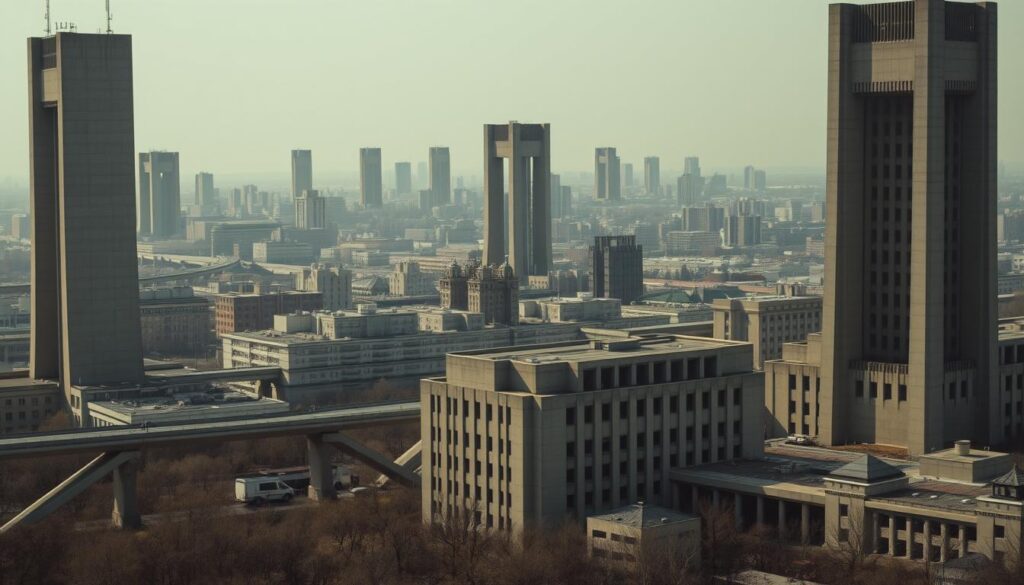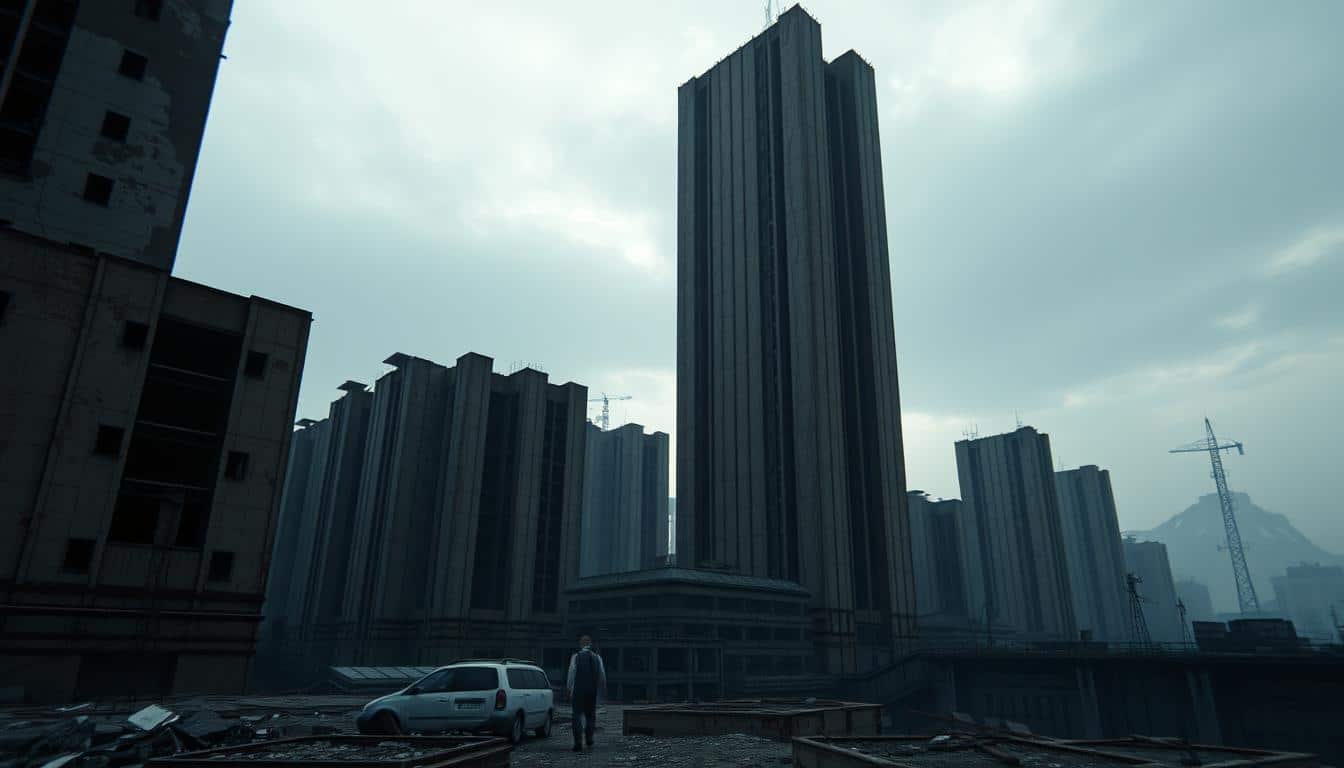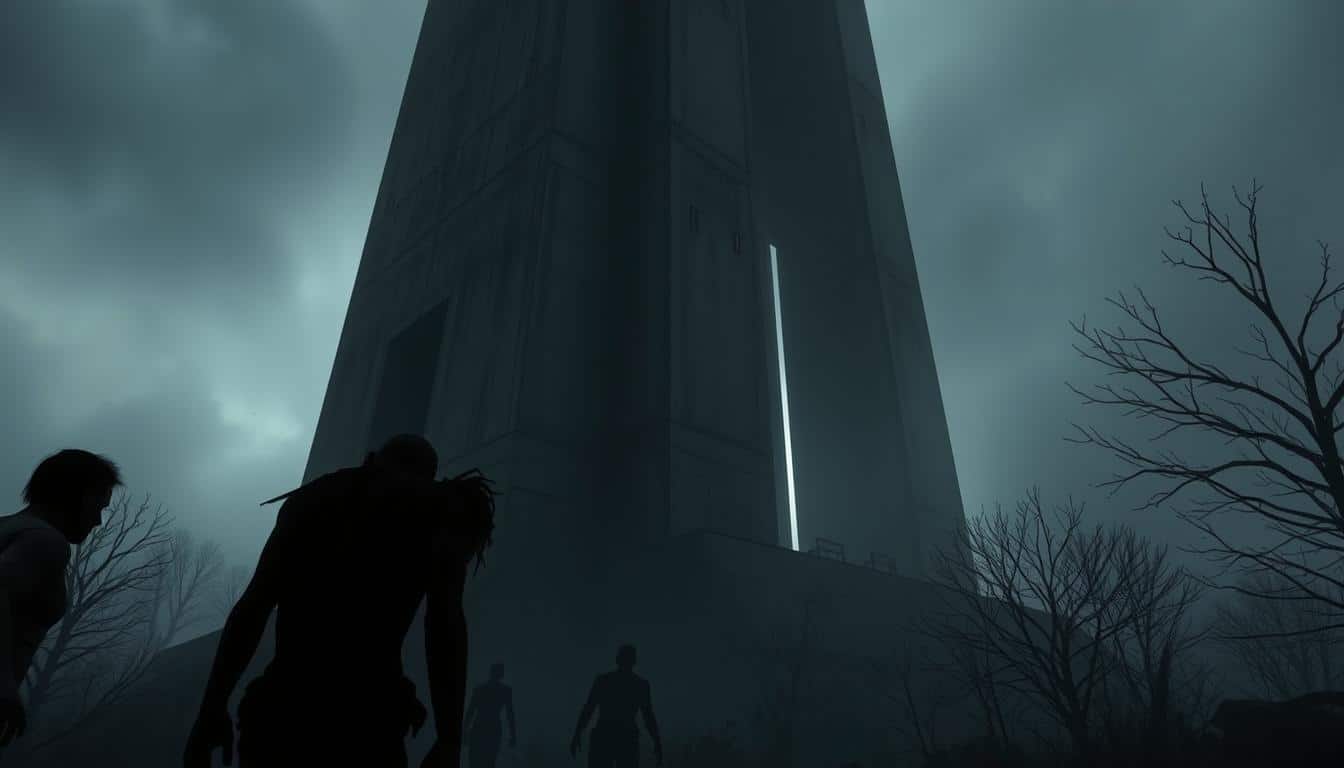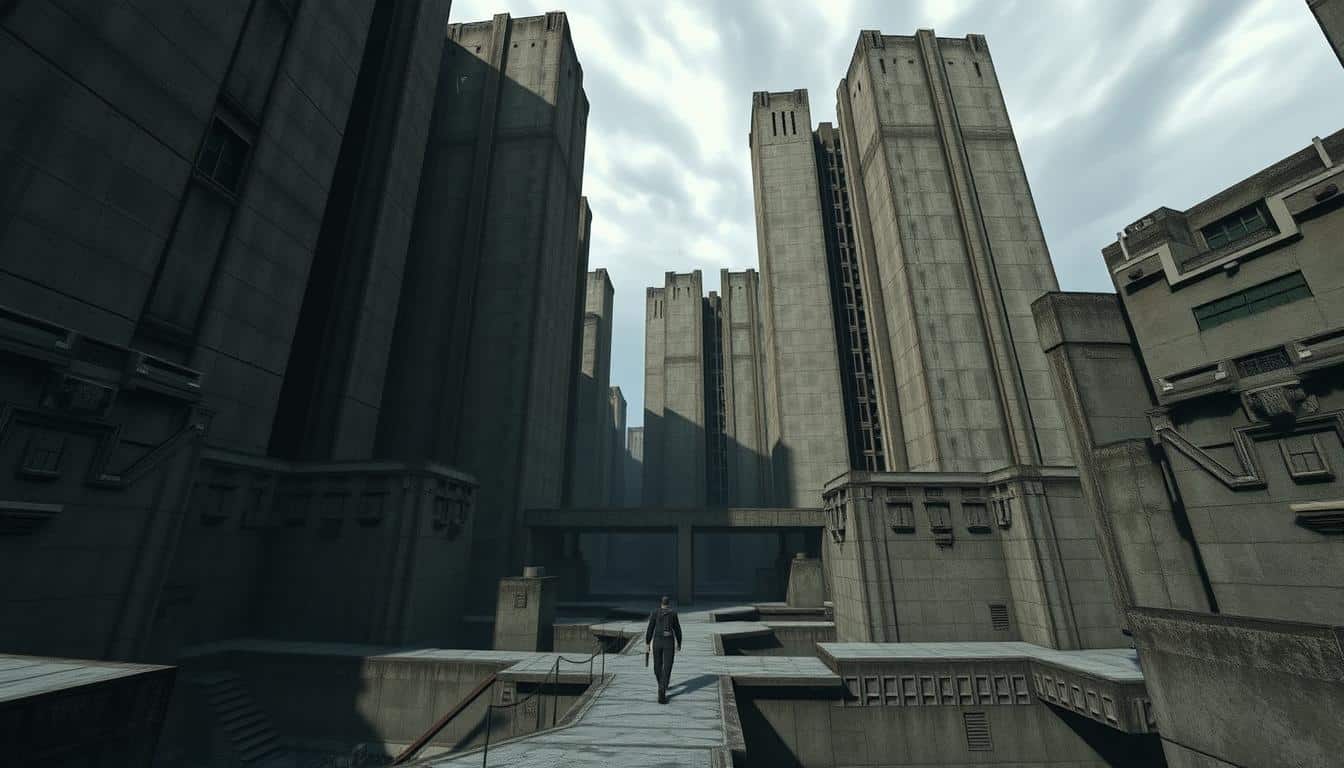Soviet Brutalism brings a unique vibe to video games. Its bold, concrete buildings shape captivating stories. This design style is famous for its straightforward and functional look.
Game creators use its look to make rich, engaging worlds. Soviet Brutalism helps to build a strong mood. It also connects deeply with players, making games more memorable. This makes it essential in today’s game design.
The Evolution of Soviet Brutalism
Soviet Brutalism became popular after World War II. It mirrored a significant period in history. This time required quick and straightforward rebuilding. Because of this, architects chose simplicity and functionality.
They focused on making buildings useful and reflecting socialist beliefs. Through unique designs, these buildings showed the power of the state. Thus, every building told a story of the time’s values, mixing politics and culture in its architecture.

Characteristics of Brutalist Architecture
Brutalist architecture is known for its brutalist features, using a lot of exposed concrete. This material gives it a look that’s both bold and imposing. The buildings have imposing forms that stick in your mind, especially in cities.
Minimalist design is at the heart of brutalist architecture. Ornamentation is minimal, putting the spotlight on the building’s shape and purpose. This approach creates a plain yet impactful visual story.
Brutalist buildings influence urban vibes deeply. Their straight lines and geometric forms bring out feelings of power and durability. This has led to their features being used in video game worlds, making those spaces feel as intense as the real ones.
The Aesthetic Appeal of Brutalism in Gaming
Brutalism in games stands out because of its unique look. The strong, raw builds in this style bring feelings of might and lastingness. They make game backgrounds full of drama. Designers pick this style to add deep feelings to the story, helping players feel more connected.
The big, bold shapes in brutalism help tell stories visually. Simple yet strong lines can show struggles or battles, pulling players in. This simplicity makes the game world feel real and full of emotion.
Games that use brutalist elements get more engaging and meaningful. These settings are not just visually striking; they touch players’ hearts. They make game experiences rich in feeling and story depth.
Notable Video Games Featuring Soviet Brutalist Influences
Several video games use Soviet brutalism’s unique features in their design and story. Games like ‘Control’ and ‘Papers, Please’ show how brutalism can add to a story. They offer a unique cultural view through their architecture.
In ‘Control’, players explore a government building filled with brutalist architecture. Its strong lines and big structures are not just for show. They play a big part in the game, affecting how it feels to play and adding to the story’s mood.
‘Papers, Please’ uses a simple yet strong setting to talk about deep topics. The game’s design makes players think about tough issues like immigration and rules. The building style helps to bring out the game’s message, linking architecture to the game’s deeper meanings.
The Impact of Soviet Brutalist Architecture on Game Storytelling
Soviet Brutalist architecture shapes game storytelling in a big way. Its distinct look adds depth to the story, pulling players into a dystopian world. It’s not just about the look; it also tells part of the story, making the game’s themes even stronger.
Creating Atmospheres of Dystopia
Brutalist aesthetics in games create a feeling of loneliness. Players find themselves in places that show how tough life can be. These harsh buildings make the game’s world feel more intense, inviting players to dive deeper into its story.
Games use this style to talk about dark themes and tough choices. It’s all about exploring what it means to be human when times are hard.
Building Emotional Connections with Players
The look of brutalism helps players feel connected to the game. It’s not just about being in a cool place. It reflects the struggles we all face. As players go through these games, they feel closer to the characters. This bond makes the game’s journey more impactful.
It encourages players to think about what it means to keep going when things get tough. They face these challenges in a world that feels real and harsh, thanks to brutalist designs.
Case Study: ‘Control’ as a Futuristic Brutalist Experience
The game Control shows us the future of brutalist architecture in gaming. It’s set in the Oldest House, a huge building that’s all about raw concrete and simple designs. This place is more than just a background; it’s a big part of the story. The design, with its changing layouts, makes things feel tense. It pulls players deep into the story.
As you play, you walk through rooms and halls that seem impossible. This adds to the game’s themes of power and control, making the story deeper. The way players interact with the game space shows how future architecture could change our stories.
In ‘Control,’ the big shapes and sharp contrasts do more than just look cool. They’re part of the game’s story, mixing building design with the plot. This case study shows how important well-designed spaces are for getting players interested. It gives us a new view on how to use brutalist architecture in games.
Case Study: ‘It’s Winter’ and Immersive Environments
The game It’s Winter takes players into a grim, post-Soviet city space. It shows the dullness and struggles of day-to-day life. The game’s focus on post-Soviet buildings lets players explore places like empty flats and lonely roads. This choice of architecture makes the game feel sadder. It makes players think deeply about the game’s world.
Experiencing Everyday Life in a Brutalist World
In It’s Winter, you really feel what immersive environments are all about. Players move through scenes showing a harsh, unfriendly reality. Here, doing the usual things matters more than meeting certain targets. The game shows everyday routines in a serious setting. This brings out the strong feelings tied to the game’s environment. As players go through these empty places, they get to think about what they see and feel. This gives a special view on how architecture and story mix in games.
Symbolism of Brutalism in Game Narratives
Game narratives use the symbolism of brutalist architecture to show themes of oppression, power, and resilience. These stark, functional designs strike a chord with players. They act as architectural metaphors that mirror the characters’ struggles in these virtual worlds.
Players come across environments where the simple forms of buildings show a sense of struggle. This mirrors their own challenges in the game.
Brutalism’s focus on functionality adds depth to player involvement. As players move through these strict structures, they see how their actions connect with their surroundings. This makes game stories more engaging. Players face obstacles but also celebrate their wins against the backdrop of this daunting architecture.
Critique of Brutalist Representation in Gaming
Games today show brutalist styles, and both players and critics have mixed feelings. Some feel these building styles are cold and push people away, hurting the game’s ability to pull them in. But others see brutalism as a deep way to show strength and the hard truths of life.
This talk about the brutalist style changes how people interact with games. Players bring their own views to the game, which can change how they feel about the game worlds developers make. So, this conversation isn’t just about what games look like. It’s also about the feelings and thoughts these game worlds create.
Talking about these critiques helps us see the big picture of architecture in storytelling. Even though brutalism is often seen as too harsh, it invites players into complex stories. These stories can push players to think differently and feel more deeply. This approach to using buildings and spaces makes the gaming world richer and more engaging.
Conclusion
The investigation of Soviet Brutalism in video games shows a big impact on how we enjoy digital worlds. This design, known for its bold look and lots of concrete, makes game worlds more real and helps tell the story better. Game makers can make players feel strong emotions by using brutalist designs, making games more than just fun but also thought-provoking.
As video games keep changing, it’s key to see how important architecture, like Soviet Brutalism, is in making good game stories. Mixing building designs with game play lets us experience stories in new ways. This lets players dive into stories that feel real and deep. This means games will keep using brutalist styles, blending architecture with digital creativity.
Looking ahead, it’s clear that the ideas of Soviet Brutalism will stay important in games. By taking inspiration from these designs, creators can make games that not only entertain but also make us think. They open up new ways for us to see and talk about buildings in our stories. This conversation between building styles and game stories will surely lead to new ideas in game creation and enjoyment.



